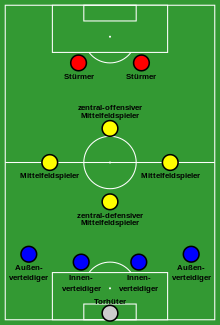Back four
The back four is a defensive formation in football with two full and central defenders, i.e. without the former libero .
In different game systems, such as the 4-4-2 , 4-5-1 or 4-3-3 system, the first number indicates the back four.
The back four is mostly played with space coverage.
The back four is the most common defense line-up in football today. The four defenders play without a Libero. The two central defenders mostly play in the transfer system against the two opposing strikers. It will seek the away free to keep playing field as small as possible. As a result, the opposing players can often be sidelined and the space for the attacking team is very tight, so that a quick and accurate passing game is necessary to overcome the back four (at the so-called interfaces of the back four). The goalkeeper “plays along”, that is, he stands far in front of the goal and is supposed to catch the long balls in the direction of the penalty area. He is also a possible passport when changing sides from one to the other full-back.
In this context one speaks of the safe distance with which the back four act. The back four act at a safe distance when they are about 20 meters in front of their own goal. At this distance, the goalkeeper has a chance of running into balls that are played by the attackers through the interfaces, while shots on goal from this distance promise little success.
However, it is a misconception that every back four automatically plays with an offside trap .
The two full-backs serve to stabilize the defense, but they are intended to strengthen the game forward via the outsides. The defense system is very complex and places high demands on each individual player. At the same time they have to guard their respective opponents, observe the game situation and keep an eye on their own players in the chain. In this context, mutual coaching of the players is important.
When playing with a back four, the midfield supports both defense and attack.
Behavior of the chain when attacked from the outside
In all attacking actions of the opponent, the back four shifts ball-oriented. If the opponent attacks from one of the outer sides, the respective full-back exerts pressure on the attacker and is protected by the central defender who is closest to him. The distance between these two players in the back four should not be too great so that the center-back can intervene if the attacker plays around the full-back. The other two players in the back four move in the direction of the ball and stagger down in order to make it difficult for the opponent to play a diagonal flying ball in the back of the defense. Any attackers on the opposite outer line are ignored.
Behavior of the chain in case of attacks through the center
Attackers who want to break through in the middle are put under pressure by the central defender close to the ball, while the other central defender and the full back close to the ball support him. In this situation, the three players form the so-called defensive triangle with the pressure-exerting central defender at the top. Ideally, the supporting players prevent the pass into the depths with their positional play, but at the same time can still take over if the attacker overcomes the pressure-exerting central defender.
history
There are various theories about the invention and development of the back four. According to the book Hundert Jahre Rapid by Karl P. Koban, Johann Skocek and Wolfgang Weisgram, she probably came to Europe from Brazil. A system that corresponds to the description of the chain of four is said to have been used there as early as 1949. From SK Rapid Wien , who had at that time otherwise taken over the Brazilian system, it has not yet adopted 1: 1, but they played with a "sweeper" (a defensive Libero) and three stoppers (defenders). According to the book, the fact that the back four were not completely taken over was due on the one hand to the fact that they could not be taught to the players quickly enough, and on the other hand because Ernst Happel was perfect as a cleaner.
The Soviet / Ukrainian coaching legend Valerij Lobanowskyj is also considered one of the fathers of the back four . In 1974/75 he won the European Cup Winners' Cup and the UEFA Super Cup with Dynamo Kiev . One of the reasons is the way of playing with a double back four and without a Libero. This influenced Western European coaches. The back four was particularly developed in the Netherlands and Italy. Arrigo Sacchi counted Lobanowskyj among his great models. Sacchi had celebrated a number of national and international successes with AC Milan between 1988 and 1990.
See also
Individual evidence
- ↑ Hundred years of Rapid by Karl P. Koban, Johann Skocek, Wolfgang Weisgram ( ISBN 3-85115-258-1 ) page 93


